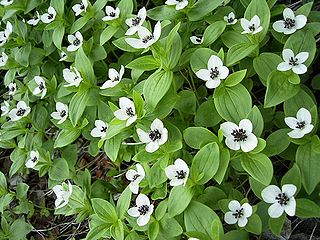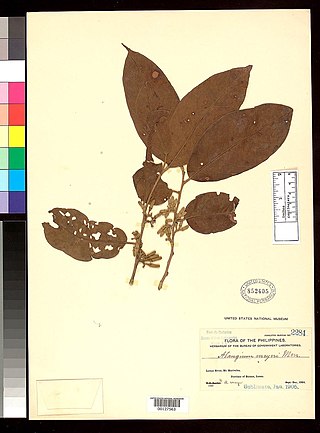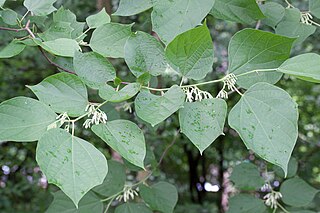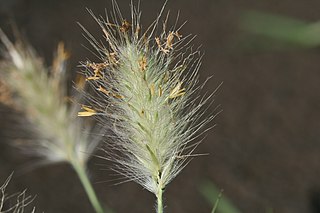
The Cornaceae are a cosmopolitan family of flowering plants in the order Cornales. The family contains approximately 85 species in two genera, Alangium and Cornus. They are mostly trees and shrubs, which may be deciduous or evergreen, although a few species are perennial herbs. Members of the family usually have opposite or alternate simple leaves, four- or five-parted flowers clustered in inflorescences or pseudanthia, and drupaceous fruits. The family is primarily distributed in northern temperate regions and tropical Asia. In northern temperate areas, Cornaceae are well known from the dogwoods Cornus.

Paphiopedilum, often called the Venus slipper, is a genus of the lady slipper orchid subfamily Cypripedioideae of the flowering plant family Orchidaceae. The genus comprises some 80 accepted taxa including several natural hybrids. The genus is native to Southeast Asia, the Indian Subcontinent, southern China, New Guinea and the Solomon and Bismarck Islands. The type species of this genus is Paphiopedilum insigne.

Alangium is a small genus of flowering plants. The genus is included either in a broad view of the dogwood family Cornaceae, or as the sole member of its own family Alangiaceae. Alangium has about 40 species, but some of the species boundaries are not entirely clear. The type species for Alangium is Alangium decapetalum, which is now treated as a subspecies of Alangium salviifolium. All of the species are shrubs or small trees, except the liana Alangium kwangsiense. A. chinense, A. platanifolium, and A. salviifolium are known in cultivation.
Alangium griffithii is a species of plant in the Cornaceae family. It is a tree found in Indonesia, Malaysia, Singapore, and Thailand.

Alangium javanicum is a species of plant in the Cornaceae family. It is found in Brunei, Indonesia, Malaysia, Singapore, and the Philippines.
Alangium longiflorum is a tree in the dogwood family Cornaceae. The specific epithet longiflorum is from the Latin meaning "long flowers".
Alangium nobile is a tree in the dogwood family Cornaceae. The specific epithet nobile is from the Latin meaning "noble" or "distinguished", likely referring to the growth habit.

Alangium chinense is a species of flowering plant in the Cornaceae family. It has the Chinese name.

Solanum retroflexum, commonly known as umsobo (isiZulu), wonderberry or sunberry, is a historic heirloom fruiting shrub. Both common names are also used for the European black nightshade in some places, particularly where the latter species has been introduced, so care must be taken to distinguish them. It is sometimes called garden huckleberry, but that properly refers to the species S. scabrum described by Philip Miller.

Ribes aureum, known by the common names golden currant, clove currant, pruterberry and buffalo currant, is a species of flowering plant in the genus Ribes native to North America.

Paphiopedilum villosum is a species of orchid found Assam, southern China and the Myanmar states of Kachin, Kayar, Shan and the Upper Sagaing region. The population is declining across its range and the species is listed as vulnerable by the IUCN due to habitat degradation and poaching for the global plant trade.

Pennisetum villosum is a species of flowering plant in the grass family Poaceae, known by the common name feathertop grass or just feathertop. It is native to northeastern Africa and parts of the Arabian Peninsula, and it is grown elsewhere as an ornamental plant. It can sometimes be found growing wild where it has escaped cultivation. This is a perennial grass growing in rhizomatous clumps, producing erect stems up to about 75 centimeters tall. The inflorescence is a panicle of clustered spikelets surrounded by a cloudlike mass of plumose white bristles up to 5 centimeters long.

Dasypyrum villosum is a species of annual grass in the family Poaceae. It is native to eastern and southern Europe and Western Asia from the Balearic Islands to Turkmenistan, including in the Mediterranean and the Caucasus regions.

Alangium polyosmoides is a rainforest tree of eastern Australia. It occurs on a variety of different soils, generally close to the coast. Found from Minmi near Newcastle to as far north as the McIlwraith Range in far northeastern Queensland. It may be seen as a common understorey plant at Wingham Brush Nature Reserve.

Solanum villosum, the hairy nightshade, red nightshade or woolly nightshade, is a sprawling annual weed in Europe, western Asia, northern Africa and is also naturalized in Australia and North America.

Wurfbainia villosa, also known by its basionym Amomum villosum, is a plant in the ginger family which is grown as a cardamom-like spice throughout Southeast Asia and South China. Like cardamom, the plant is cultivated for its fruits, dry capsules containing strongly aromatic seeds. W. villosa is an evergreen monocotyledonous plant 1.5 to 3.0 m in height, the branches and leaves of which are similar to those of ginger. It grows in the shade of trees and has a reproductive peculiarity whereby those flowers borne on creeping growth at ground level will set fruit, while those borne on aerial branches will not. It blooms in March and April, the colour, translucency and waxy lustre of the flowers being likened traditionally to those of white jade.

Alangium salviifolium, commonly known as sage-leaved alangium, is a flowering plant in the Cornaceae family. It is also commonly known as Ankolam in Malayalam, Ankola in Kannada, Akola or Ankol in Hindi and Alanji in Tamil. In India, Its mostly found in dry regions in plains and low hills and also found on roadsides.
Alangium kurzii is a tree in the family Cornaceae. It is named for the German naturalist Wilhelm Sulpiz Kurz.

Sedum villosum, known as the hairy stonecrop or purple stonecrop, is a biennial to perennial flowering plant. Its leaves, which are 3–8 mm (0.1–0.3 in) long and may be reddish in colour, are generally covered with hairs, although S. villosum var. glabratum may have hairless leaves. Individual flowers have five pink petals, each up to 5 mm (0.2 in) long.

Koanophyllon villosum, the Florida Keys thoroughwort, or abre camino, is a species of flowering plant in the family Asteraceae. It grows in southern Florida, Cuba, the Bahamas, Hispaniola, Jamaica, and the Islas de la Bahía.
















